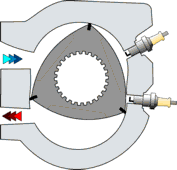 JDM Importing Guide
JDM Importing Guide
The Beginners Guide to Importing from Japan. A must-read before importing JDM. Your FREE guide contains industry tips to getting the best deal on your JDM Import and is now available for download directly. Download Your Guide Over 7,000 copies Downloaded! We respect your Privacy. |
|
|
|
|
|
|
|
|

How the RX-7 Rotary Engine WorksWritten by Gerry Martselos 
Introduction to the Rotary: The Rotary engine has never been fully understood by the general public. What is not understood is generally not accepted, and as such, the rotary engine has remained within a cult following for the majority of it’s existence. If only a portion of the millions of hours of R&D work on the piston engine could have been shared with the Rotary engine.
Those who understand this engine are fanatical to the point of addiction. The rotary engine is commonly used in aircraft, and as most every car enthusiast knows, Mazda has been making Rotary powered sports cars for years. The concept of the rotary is ideal, designed using simple mathematical principles:
The purpose of a typical internal combustion engine is to mix air with fuel, compress that mixture and ignite it to produce an explosive force. This explosive force is contained within a cylinder and during the combustion stroke. The piston is then used to apply this force to the crankshaft through the connecting rod. This complex design (we won’t even get into the valve train) allows the chemical energy of the air and fuel to be converted into rotational force. But what if there was another way? The typical internal combustion engine contains hundreds of moving parts. This is because the design of this stationary combustion chamber that requires valving able to open and close precisely to allow the air and fuel in, and the exhaust out. During the compression and combustion strokes, those valves must be sealed tight. If the purpose of an internal combustion engine is to compress air and fuel into an expandable container and ignite it to harness the energy, couldn’t there be a better way? There is, and most have never received the chance. The internal combustion engine is too well established. We already have the machines to make them, we’ve spent billions developing them, and there is an industry trained to maintain these engines. Why on earth would the car companies wish to suddenly change or try something completely different? Lucky for us, there’s Mazda. Mazda is the automotive equivalent for “Mikey”, they’ll try anything. And sometimes, they get it right!
How the Rotary Engine Works through Video: With a rotary engine, the opening and closing of the intake and exhaust valves is built right into the design of the engine. No Valvetrain required! Take a look at this animated video and you’ll soon understand
As the rotor moves past the intake and exhaust ports, they are “opened” and “closed” as required. The shape of these ports dictates how long they are open. In a rotary engine, the combustion chamber is not what you typically expect. As the rotor compresses the air fuel mixture against the wall of the housing, it is ignited and applies force to the rotor, which in turn applies force to the eccentric shaft. This is how power is made. More Videos:
Pistons aren’t being forced to accelerate and decelerate at ridiculous speeds. There is no valve train to “float” open at high rpms, Due to the dimensions of the engine, the output shaft rotates at 3X the speed of the rotor. This Animation illustrates this key strength of the rotary engine. The output shaft is moving at 3X the speed of the rotor, which in turn means the rotor is only moving at 1/3 the speed of the output shaft (gotta love simple math!). This is due to the cycloidal gearing of the engine. When you’re screaming your rotary engine past 9,000Rpms (*not recommended), the rotors are traveling at a leisurely 3,000RPMS. The engine is able to have the rotors spin slowly while putting out sufficient RPMs at the output shaft. The dual rotor design is optimal for creating balance between the two rotors as shown here: This video explains the oiling system functions and layout. Want more rotors? If more cylinders are better, why not rotors? Drag Racing BMW with a 4 Rotor Engine: Mazda has an impressive list of victories they have racked up over the years using rotary powered cars. The first win ever by a Japanese automaker at Le Mans was performed in 1991 by the 4rotor Mazda 787B. The Mazda 787B Warming up:
Information Source : How a rotary works by parts Mazda RX-7 Information
|





